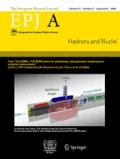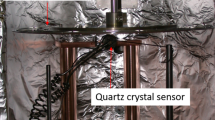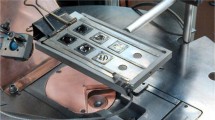Abstract
The direct measurement of reaction cross-sections at astrophysical energies often requires the use of solid targets of known thickness, isotopic composition, and stoichiometry that are able to withstand high beam currents for extended periods of time. Here, we report on the production and characterisation of isotopically enriched Ta2O5 targets for the study of proton-induced reactions at the Laboratory for Underground Nuclear Astrophysics facility of the Laboratori Nazionali del Gran Sasso. The targets were prepared by anodisation of tantalum backings in enriched water (up to 66% in 17O and up to 96% in 18O. Special care was devoted to minimising the presence of any contaminants that could induce unwanted background reactions with the beam in the energy region of astrophysical interest. Results from target characterisation measurements are reported, and the conclusions for proton capture measurements with these targets are drawn.
Similar content being viewed by others
References
C.E. Rolfs, W.S. Rodney, Cauldrons in the Cosmos (The University of Chicago Press, 1988).
C. Iliadis, Nuclear Physics of Stars (Wiley-VCH, New York, 2007).
H. Costantini et al., Rep. Progr. Phys. 72, 086301 (2009).
C. Broggini et al., Annu. Rev. Nucl. Part. Sci. 60, 53 (2010).
S. Palmerini, M. La Cognata et al., Astrophys. J. 729, 3 (2011).
C. Iliadis, A. Champagne et al., Astrophys. J. Suppl. Ser. 142, 105 (2002).
S. Seuthe et al., Nucl. Instrum. Methods A 260, 33 (1987).
D.A. Scott, to be published in Phys. Rev. Lett. (2012).
D. Phillips, Nucl. Instrum. Methods 116, 195 (1974).
D.A. Vermilyea, Acta Metall. 1, 282 (1953).
N. Cabrera, N.F. Mott, Rep. Progr. Phys. 12, 163 (1949).
M.P. Seah et al., Nucl. Instrum. Methods B 30, 128 (1988).
M. Wiescher et al., Nucl. Phys. A 349, 165 (1980).
A. Formicola et al., Nucl. Instrum. Methods A 507, 609 (2003).
J.F. Ziegler, Nucl. Instrum. Methods B 219, 1027 (2004) H. Andersen, J.F. Ziegler, The Stopping and Ranges of Ions in Matter.
W.A. Fowler et al., Rev. Mod. Phys. 20, 236 (1948).
M.A.N.W.K. Chu, J.W. Mayer, Backscattering Spectrometry (Academic Press, 1978).
M. Mayer, AIP Conf. Proc. 475, 541 (1999).
D. Phillips, J.P.S. Pringle, Nucl. Instrum. Methods 135, 389 (1976).
F.G.R.A. Benninghoven, H.W. Werner, Secondary Ion Mass Spectrometry: Basic Concepts, Instrumental Aspects, Applications, and Trends (Wiley, New York, 1987).
J.P.S. Pringle, J. Electrochem. Soc. 119, 482 (1972).
Author information
Authors and Affiliations
Consortia
Corresponding author
Additional information
Communicated by D. Pierroutsakou
Rights and permissions
About this article
Cite this article
LUNA Collaboration., Caciolli, A., Scott, D.A. et al. Preparation and characterisation of isotopically enriched Ta2O5 targets for nuclear astrophysics studies. Eur. Phys. J. A 48, 144 (2012). https://doi.org/10.1140/epja/i2012-12144-0
Received:
Revised:
Accepted:
Published:
DOI: https://doi.org/10.1140/epja/i2012-12144-0




